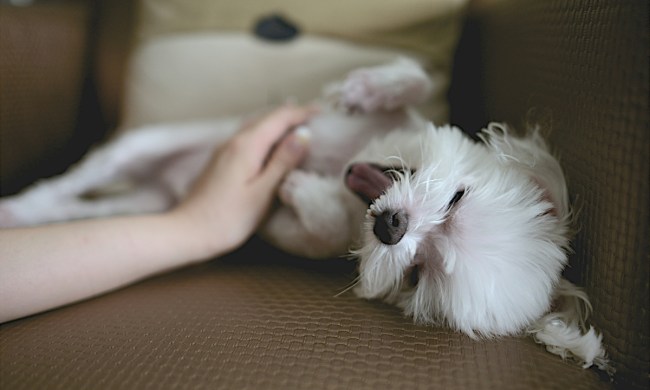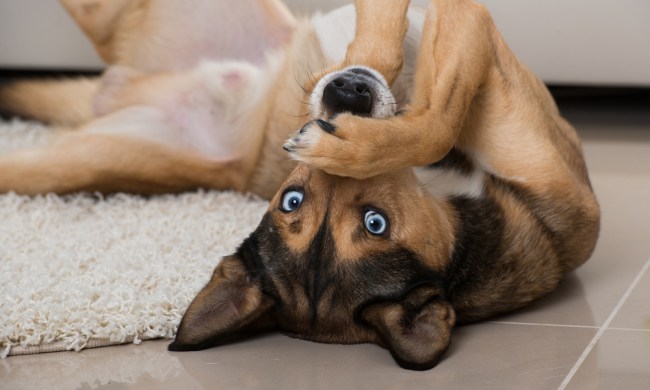Fall is in full swing, which means dog shedding season is, too. This is the time of year when many dog owners break out the lint rollers and the de-shedding brush, but you’ll be happy to know that these tried-and-true tools aren’t the only things that can help. Your clothes and furniture will thank you for trying something new.
You may have heard of a de-shedding grooming appointment or tried pet hair-repellent laundry products, but we compiled nine tips and tricks to make dog shedding season more tolerable. Then, you can get back to enjoying cool fall days with your pup.
Which dogs shed in the fall?

Not all dogs are created equal when it comes to shedding. Some dog breeds naturally shed more in autumn than others, but other factors can affect how much (and when) a dog sheds.
While there’s technically no such thing as a non-shedding dog, most indoor dogs shed lightly year-round due to moderate indoor temperatures. This is because a dog’s shedding is triggered by changes in temperature throughout the year. Outdoor dogs, Nordic breeds, and those with double-layered coats are more likely to shed completely in spring and fall. On the one hand, it can be nice to have a break from the shedding, but this seasonal shedding tends to be a lot heavier!
Dogs breeds with double-layered coats include:
- Bernese mountain dogs
- Retriever breeds like Labradors and golden retrievers
- Smooth and rough-coated collies
- German shepherds
- Pomeranians
- Siberian huskies and other Nordic dog breeds
- Chow Chows
- Newfoundlands
and more!
How to manage shedding in the fall

No matter what breed of dog you have or what time of year it is, it’s important to get on top of shedding before it overwhelms you, your dog, or even your dog’s groomer. Here are some helpful tips to try out.
A bath or grooming appointment can go a long way
Sometimes, you need to go back to basics. A bath with a de-shedding shampoo can help loosen the undercoat that will fall out throughout dog shedding season. Your dog won’t shed less, but they may get it over with all at once if you can help to loosen the fur. If this task is too big to handle at home, it’s the perfect time to enlist the help of a dog groomer. With their tools and expertise, they can handle the brunt of the shedding. Remember to tip these heroes generously.
Daily brushing and coat care are essential
Staying on top of brushing and grooming can also keep shedding under control. You can help remove loose fur from the undercoat without it falling out all over your house. Tangles and matted fur can also prevent loose fur from falling off, so be sure to brush your dog’s coat daily.
Use a de-shedding tool
When brushing your dog (especially during dog shedding season), using the correct tool can make a huge difference. Look for an undercoat rake that can gather loose fur without pulling on your dog’s hair or nicking their skin. Your local groomer may have recommendations, or you can check out our list of best brushes for shedding.
Keep an eye out for allergies, stress, and infections
Sometimes, excess shedding isn’t normal. It may take a trained eye to notice when shedding becomes too much, but if you notice bald spots on your dog or clumps of fur falling out (outside of standard shedding), then a visit to the vet may be necessary. There are a number of conditions, most of which are easy to cure, that can cause hair loss in dogs. Anything from allergies to infections and even stress could cause a dog to lose their hair.
Feed your dog a balanced diet
Nutrient deficiencies are common but easily solvable problems that can result in hair loss. There are a number of supplements that may aid in this situation, but this may also warrant a vet visit so you can ensure your dog is getting the balanced diet they need to thrive.
Keep your dog hydrated
Something as simple as hydration can be the difference between normal and excess shedding. When your dog is dehydrated, their skin becomes dry and lets go of loose fur more easily. Lombard Veterinary Hospital recommends that a dog drinks one ounce of water per pound of body weight to maintain a healthy and hydrated coat.
Try pet hair-repellent laundry products
If you’ve done all you can to tackle shedding at the source, it’s time to manage the dog “glitter” that’s decorating your home. Pet hair-repellent laundry products can work wonders to keep dog fur off of your clothes for days or even weeks after you wash. If you’re open to some trial and error, you’re bound to try something that worked for you!
Keep lint rollers on hand — everywhere
Sometimes, you only have a minute to get rid of pet hair. That’s when the good old lint roller comes in handy. It may seem tedious to have these sticky tools in every room, but your future self will thank you when you’re in a rush to leave the house without looking like your dog came with you.
Pet gates and training can keep fur in one area of the home
Pet gates can be helpful in a number of situations, including keeping shedding confined to one area of the home. This isn’t meant as a long-term solution, but it can be ideal for short events like holidays and parties.
When you own a shedding dog, however, you’ll have to accept that fur is an ever present part of your life. It’s a small sacrifice to make for the unconditional love of a dog, but remember: shed happens!




